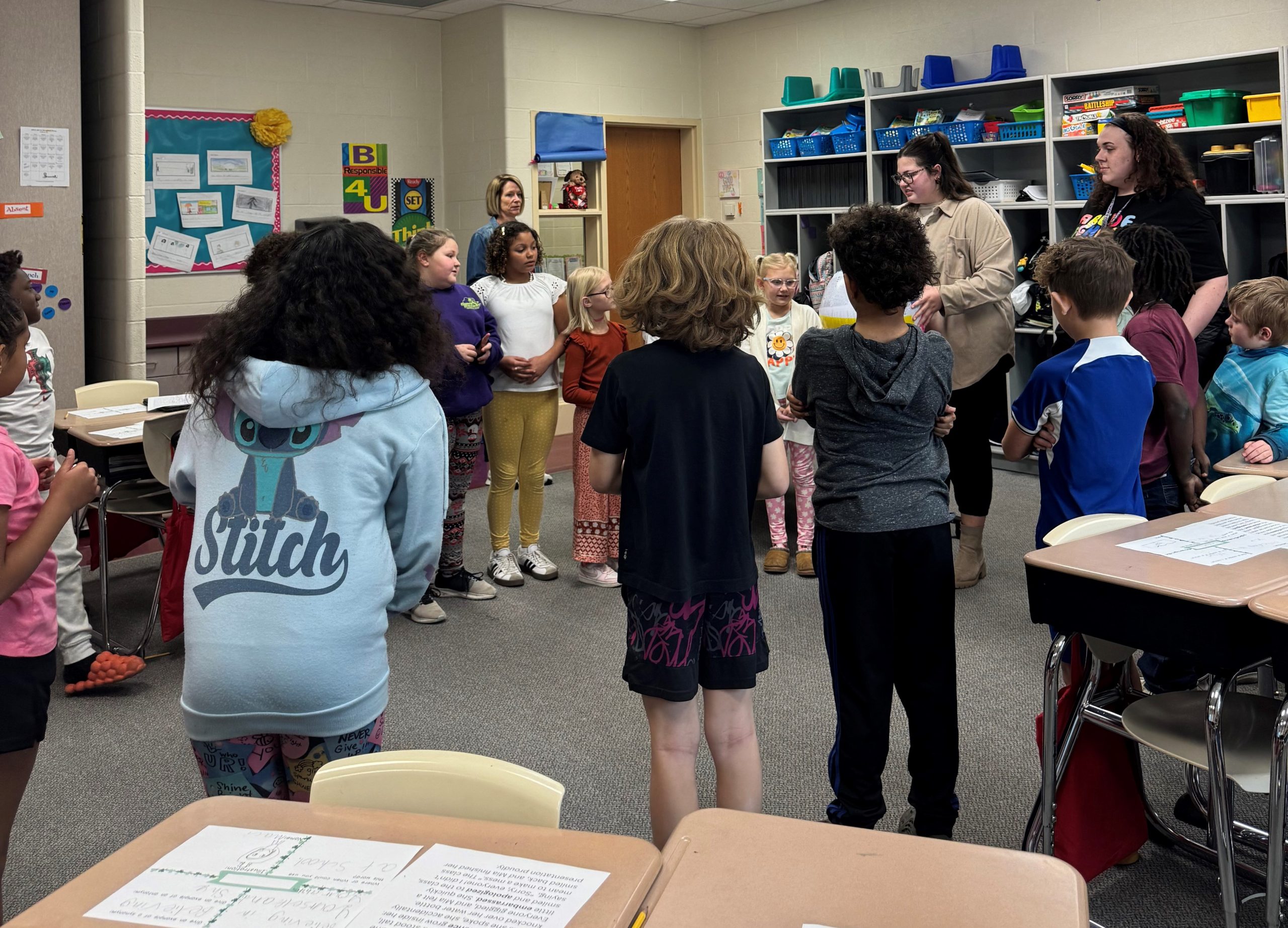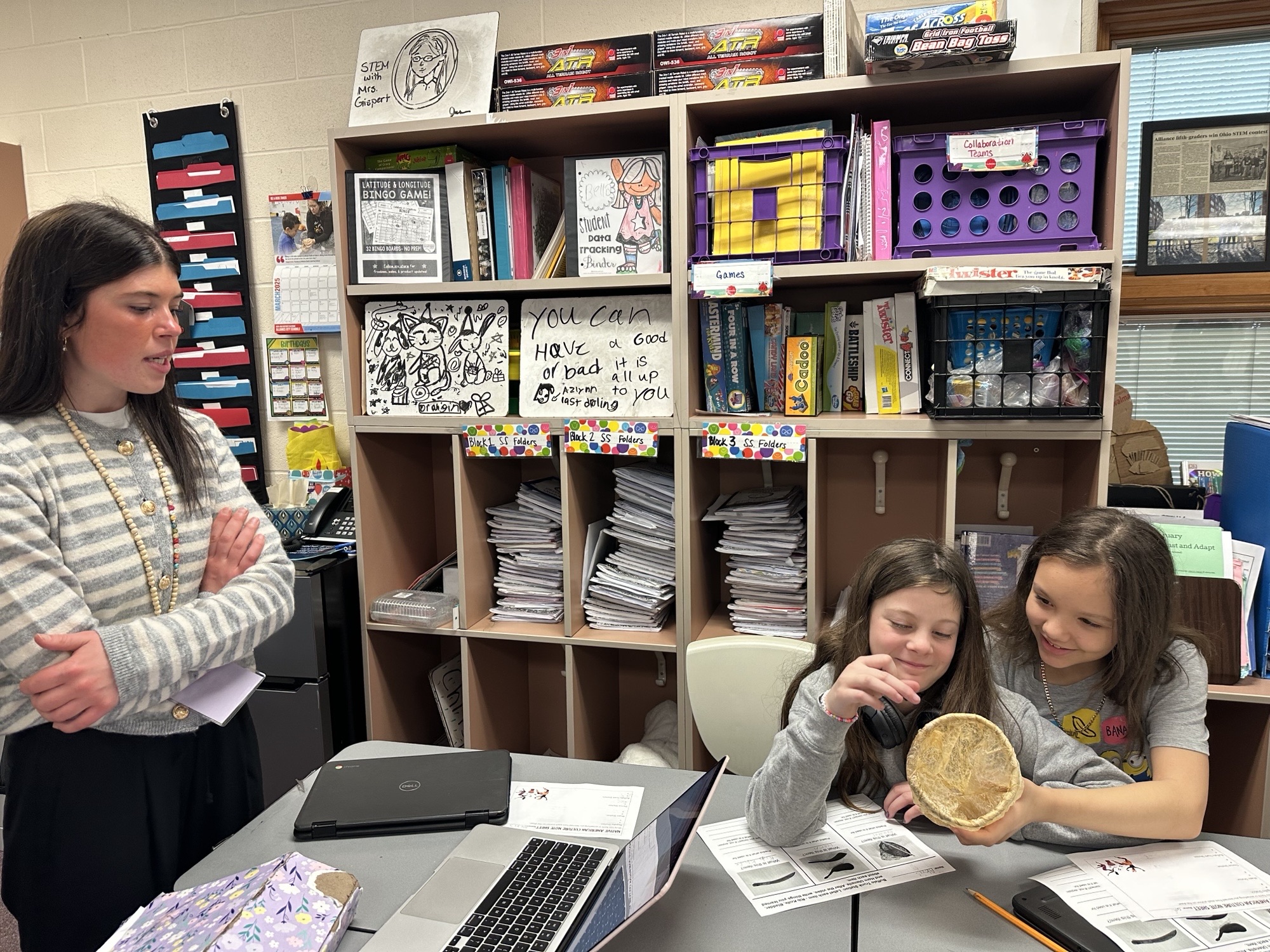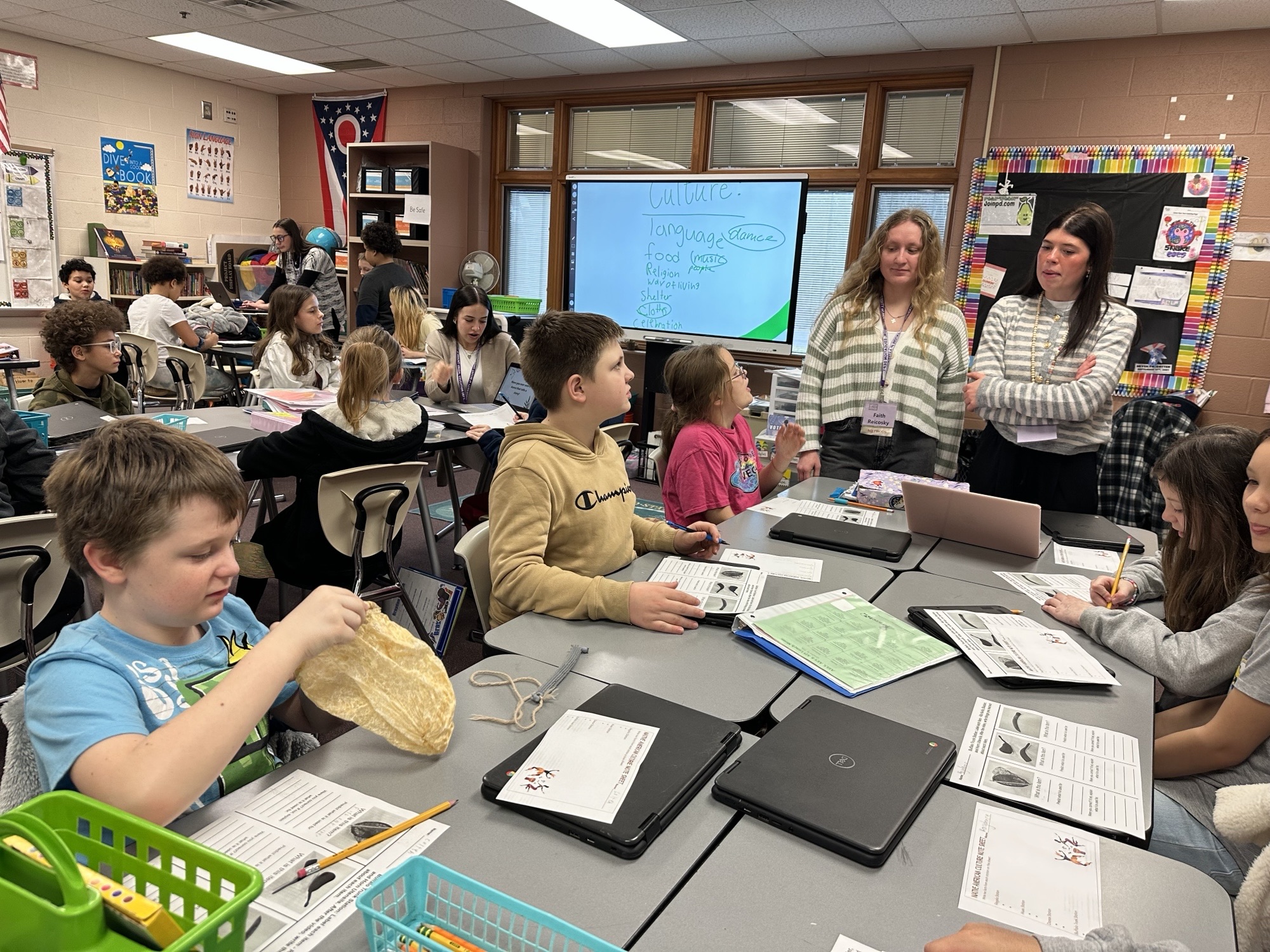


UMU Lesson Plan--Inside and outside parts of the buffalo
Buffalo Trunk
Main resource used in this lesson plan from ahtove.org
View complete lesson plan below
Authors: Jillian Zamarelli and Ashlin Morris, edited by Dr. Mary Beth Henning (henninma@mountunion.edu) |
Period: Approximately 60 minutes |
Grade Level: 4th grade |
Subject: Native American Social Studies: Uses of the Buffalo |
The Context for the Lesson:
This lesson was taught to a group of 25 students, including 16 boys and 9 girls, rich in diversity, with both African American and Caucasian students. In the classroom, 12 students have Individualized Education Programs (IEPs) for reading, and 1 student has a 504 Plan. These students enjoy the use of visuals and physical objects and collaborating with their peers.
The lesson will focus on the historical and cultural significance of the buffalo to Native American tribes, highlighting how the buffalo was used for food, clothing, tools, and ceremonial purposes. This information will be presented through multiple artifact images, stories, and videos about buffalo usage in Native American culture.
By fostering a collaborative environment and using scaffolding, the lesson enables students to discover and explore Native American culture together, supporting both cognitive and social development in line with Vygotsky’s theory that learning is a socially constructed process.
Ohio Social Studies Standard Grade 4.20 Tables and charts organize data in a variety of formats to help individuals understand information and issues.
ISTE Technology Standard 2.5.c Create Innovative Learning Environments-Explore and apply instructional design principles to create innovative digital learning environments that engage and support learning
Learning Objective:
Students will analyze buffalo artifacts and images and organize their findings in a chart while also making connections between Native American Culture and how the parts of the buffalo were used by Native Americans.
Academic Language:
Artifact: An old object made by people that tells us about how they lived a long time ago.
Buffalo Artifacts: A collection of items made from buffalo that Native Americans used in their daily lives.
Culture: The way a group of people lives, including their traditions, beliefs, and things they create.
Resource: Something from nature that people use to help them live, like animals, plants, or water.
Tradition: A special way of doing something that people pass down from one generation to the next.
Preserve: To keep something safe or in good condition so people in the future can learn from it.
Respect: To treat people, animals, and nature with kindness and care.
Artifacts to be used in this lesson that are found on ahtove.org:
Buffalo Horns: The hard, curved part on a buffalo’s head that helps protect it and show strength. Native Americans used this part of the buffalo for many things like cups. The horn is made up of compacted hairs and can be bent and shaped when put in hot water.
Buffalo Hoof: The tough, flat feet of a buffalo that help it walk on grassy lands and run fast. Native Americans used hooves for things cups and to make soups.
Buffalo Tail: The long, swishy part at the back of a buffalo’s body that helps keep bugs away. Native Americans use this part of the buffalo as a flyswatter.
Buffalo Bladder: A special part inside a buffalo’s body that holds its pee. It can be used by Native Americans to hold things such as water.
Buffalo Rib: The bones in the buffalo’s body that protect its heart and lungs. They also help Native Americans to make tools.
Buffalo Leg Bone: Strong bones in a buffalo’s legs that help it run and jump. These bones can also be used to make tools.
Native Americans: A group of people who were the first to live in North America. They have many different cultures, languages, and traditions that have been passed down for thousands of years.
Assessment Plan
In addition to using the charts that will be filled out by the students, the students teach and present information that they have learned to the opposite group of students. By doing this, students will become experts on the specific parts of the buffalo while also learning additional aspects from their peers.
Toward the end of the lesson, students will have learned about the inside and outside parts of the buffalo and how the artifacts are used by Native Americans. After students have worked through the lesson activities and completed the learning objective for the day, each student will be instructed to complete an exit ticket that pertains to what they have learned.
On the exit ticket, individual students will draw a picture of one of the artifacts from the buffalo that they learned about. In addition to this, the students will be instructed to write a sentence to explain what Native Americans used the artifact for. Students will be given the option to pick the artifact that they find most interesting and write about it. If needed, students can physically show one of the artifacts they liked from the lesson and verbally explain how Native Americans used it.
Procedures, Lesson Introduction: (10 Minutes)
- As a warm-up, students will be asked to write down on a sticky note one sentence or draw a picture of what they remember learning about Native Americans and their culture.
- Explain the importance of culture and that everyone has their own special traditions and way of life. Express that it is important to respect other people’s culture and that culture can evolve over time.
- Students will be given 2 minutes to brainstorm with their groups and they write or draw their answers on a sticky note.
- After the students have come up with a good answer on their sticky notes, instruct them to post their sticky notes on the whiteboard.
- As a class, discuss the answers and talk about the importance of culture.
- Tell students that we will be learning more about Native Americans and the different objects and tools they use daily using buffalo artifacts.
- “Today you will all become experts about different parts of the buffalo!”
- A student can read the “I can” statement: “I can learn about the different parts of the buffalo and how Native Americans used them in everyday life!”
Procedures, Lesson Body:
Video Activity: (5 Minutes)
- Gather on the carpet to watch a short video about the Buffalo and how it impacted the Native American culture.
- After the video, students will take turns in groups sharing something they noticed or learned from the video
- Explain how Native Americans used many different parts of the buffalo for different things. The items that they will see were created from the buffalo and were handcrafted in the ancient manner of the Northern Cheyenne by Randall Tall Bull.
- At this point in the lesson, the students will clear their desks and prepare for the next parts of the lesson.
Preparation for Buffalo Activity: (5 Minutes)
- Split students into two groups.
- Both groups will need their designated worksheets, artifacts, and writing utensils.
BUFFALO ARTIFACT ACTIVITY: (25 Minutes)
- GROUP #1 (RED) Will be looking at the parts of the buffalo that are inside the animal body: Bladder, ribs, leg bone
- EXAMPLE: Buffalo bone and ribs that were used as knives for cutting things.
- GROUP #2 (BLUE) Will be looking at parts of the buffalo that are outside of the animal body: Horns, tail, buffalo hooves
- EXAMPLE: Buffalo hides are used for Native American regalia.
After students are split into groups:
- Students will be instructed to sit with their groups in different areas of the classroom.
- GROUP #1 (Inside of Buffalo)
- GROUP #2 (Outside of Buffalo)
- Direct students to use the ahtove.org website to learn from primary sources how their artifacts were crafted, what they are used for, and other interesting facts. Or use a slide presentation with video clip links.
COOPERATIVE LEARNING EXPERIENCE WITH ARTIFACTS:
- Students will be instructed to verbally predict what the different parts of the animal are used for before observing and learning about the artifacts and how they were used.
- The students will be given time to talk about the images and artifacts and discuss what they think the Native Americans used the items for. (Make inferences about the artifacts and images)
- Each group will fill out a chart that relates to their assigned parts of the buffalo.
GROUP WORK- Becoming experts on the parts of the buffalo:
Once students are organized in their groups with all of their materials they will…
- Look at images/videos/AR and take notes of the images using a graphic organizer/chart.
- Discuss with their groups what they have learned and talk about things they have found interesting.
- Make a plan to present their findings on each artifact to the opposite group.
- Students will end this activity with their groups and become experts on their assigned parts of the buffalo.
- They will then teach their peers about what they learned during their time in their cooperative learning groups.
PEER LEARNING AND TEACHING: (10 Minutes)
- Students will take turns teaching each other about what they learned in their groups.
- To make sure that all students are engaging with the activity, pass out another graphic organizer to the students who are not presenting their work so that they can fill it out as they learn from the group experts.
- EXAMPLE: As group #1 is presenting the information they learned about the inside parts of the buffalo and how they were used, Group #2 will fill out the graphic organizer that group #1 already completed during the cooperative learning activity that was done in small groups.
Presentation Instructions:
- Each group will be instructed to present their information to the class:
- Show the class the artifact they were learning about.
- List the names of the artifacts.
- Explain how Native Americans create the artifacts.
- Tell the class their thoughts about the artifacts.
Lesson Closure: (5 Minutes)
- Pass out the exit ticket to each student.
- Direct students to draw a picture of a buffalo trunk artifact and write one sentence explaining why it was important to Native Americans.
- If there is extra time, instruct each table group to come up with one question that they may have about the Native Americans and the buffalo artifacts.
- Students may also examine other artifacts from the buffalo on ahtove.org that we did not cover in the lesson
- Local History: Discuss how studying artifacts from indigenous cultures connects to learning about early Ohio settlers and the interactions between Native Americans and European explorers.
Instructional Materials and Support:
- https://ahtove.org/buffalo-trunk/
- Lesson Plan Slides
- Buffalo Worksheets
- Exit Ticket
- Inside of Buffalo Slides (guided use of ahtove.org)
- Outside of Buffalo Slides (guided use of ahtove.org)
- Exit Ticket Rubric
- Pencil
- Laptop
- Smartboard
- Sticky Notes
- Buffalo Artifacts
